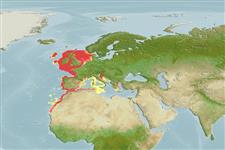Пластиножаберные (акулы и скаты) (sharks and rays) >
Rajiformes (Skates and rays) >
Rajidae (Skates)
Etymology: Raja: Latin, raja, -ae = a sting ray (Raja sp.) (Ref. 45335).
Environment: milieu / climate zone / пределы глубины / distribution range
экология
морской демерсальный; пределы глубины 10 - 380 m (Ref. 6808). Temperate; 60°N - 22°N, 18°W - 24°E
Eastern Atlantic: Shetland Islands to Morocco, Rio de Oro (Western Sahara), and Madeira.
Length at first maturity / Size / Вес / Возраст
половая зрелость: Lm 90.2, range 60 - ? cm
Max length : 120 cm TL самец/пол неопределен; (Ref. 41333); 125.0 cm TL (female); наибольший вес (опубликованные данные): 14.3 kg (Ref. 40637)
колючие лучи спинного плавника (общее число) : 0; колючие лучи анального плавника: 0. Upper surface wholly prickly, except in juveniles; underside only prickly along front margins of disc; orbital thorns separate; a regular median row of 40-45 thorns in juveniles and adult females, interrupted on back in males; 60-90 tooth rows; upper surface ochre, with numerous small dark spots to margins of disc, underside white (Ref. 3167).
Body shape (shape guide): other; Cross section: flattened.
Found on sand and sand-rock bottoms (Ref. 6808). Feed on all kinds of benthic animals (Ref. 3167). Oviparous. Distinct pairing with embrace. Young may tend to follow large objects, such as their mother (Ref. 205). Eggs are oblong capsules with stiff pointed horns at the corners deposited in sandy or muddy flats (Ref. 205). Egg capsules are 10.0-14.3 cm long and 5.8-9.0 cm wide (Ref. 41250). About 40-90 eggs are laid per individual every year (Ref. 41250).
Oviparous, paired eggs are laid. Embryos feed solely on yolk (Ref. 50449). Spawning mainly from February to August with at least 30 egg-cases laid (Ref. 3167). Distinct pairing with embrace. Young may tend to follow large objects, such as their mother (Ref. 205).
McEachran, J.D. and K.A. Dunn, 1998. Phylogenetic analysis of skates, a morphologically conservative clade of elasmobranchs (Chondrichthyes: Rajidae). Copeia 1998(2):271-290. (Ref. 27314)
Статус Красного Списка МСОП (Ref. 130435: Version 2025-1)
Угроза для людей
Harmless
Использование человеком
рыболовство: не имеет хозяйственного значения; объект спортивного рыболовства: да
дополнительная информация
инструменты
Специальные отчеты
Скачать в формате XML
ресурсы в Интернет
Estimates based on models
Preferred temperature (ссылка
123201): 7.1 - 16.2, mean 10.3 °C (based on 462 cells).
Phylogenetic diversity index (ссылка
82804): PD
50 = 0.5000 [Uniqueness, from 0.5 = low to 2.0 = high].
Bayesian length-weight: a=0.00224 (0.00144 - 0.00348), b=3.27 (3.15 - 3.39), in cm total length, based on LWR estimates for this species & Genus-body shape (Ref.
93245).
Trophic level (ссылка
69278): 3.8 ±0.61 se; based on food items.
устойчивость к внешним воздействиям (ссылка
120179): низкий, минимальное время удвоения популяции 4.5-14 лет (K=0.12-0.19; tmax=15; Fec=40).
Prior r = 0.20, 95% CL = 0.13 - 0.30, Based on 1 full stock assessment.
Fishing Vulnerability (Ref.
59153): High to very high vulnerability (65 of 100).
🛈
Climate Vulnerability (Ref.
125649): High vulnerability (61 of 100).
🛈
Nutrients (Ref.
124155): Calcium = 4.69 [0.73, 84.95] mg/100g; Iron = 0.26 [0.02, 2.99] mg/100g; Protein = 16.7 [13.9, 19.0] %; Omega3 = 0.869 [0.349, 2.113] g/100g; Selenium = 14.8 [3.0, 71.4] μg/100g; VitaminA = 7.7 [0.6, 90.3] μg/100g; Zinc = 0.31 [0.02, 3.43] mg/100g (wet weight);
